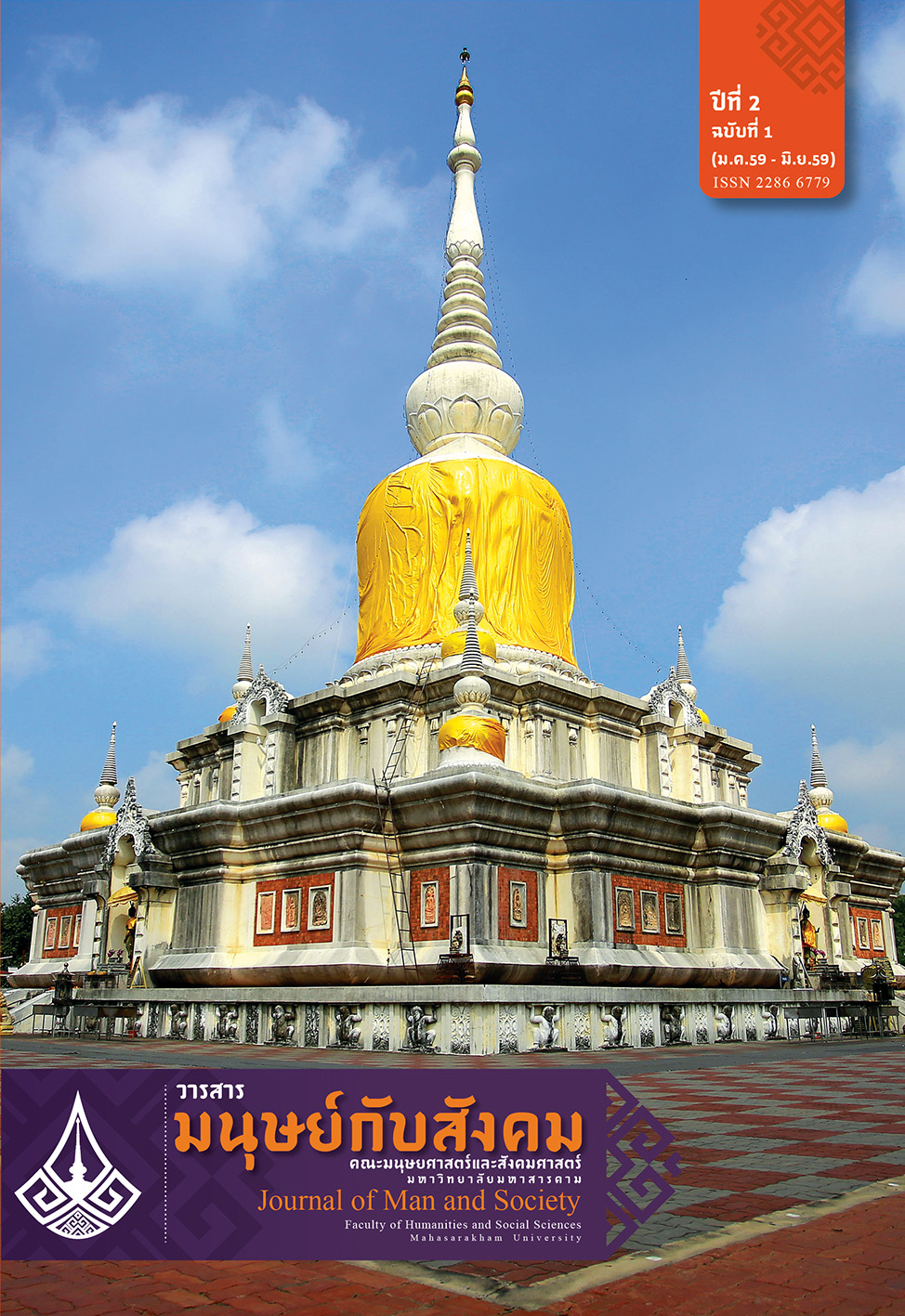Cultural Meanings in the Mythof Makamlai
Main Article Content
Abstract
The objective of this article is to study the legend of Makamlai (i.e. Kamlai Horse) in cultural terms from the local legend in Phen District, UdonThani Province by considering the legendary person and his companion: Phra Sri That and Makamlai. The legend affects the local people’s thoughts, beliefs and cultural rituals. According to the findings, it was found that the legend had four cultural influences the Ban That Community as follows: 1) Reflection the history of people in the past and the construction of city, 2) leading to Song Makamlai Ritual, 3) linking Song Makamlai Ritual and Boon Bung Fai Festival together, and 4) reflecting religious beliefs and holiness. This study indicated that the cultures were created from ancient beliefs and mixed with the local rituals and then created practices that have been inherited since then. This is an idea for promoting harmony, faith in sacred things and ancestors, social rules and religion.
Article Details

This work is licensed under a Creative Commons Attribution-NonCommercial-NoDerivatives 4.0 International License.
เนื้อหาและข้อมูลที่ตีพิมพ์ลงในวารสารมนุษย์กับสังคม ถือเป็นข้อคิดเห็นและความรับผิดชอบโดยตรงของผู้เขียนซึ่งกองบรรณาธิการวารสารไม่จำเป็นต้องเห็นด้วยหรือร่วมรับผิดชอบใดๆ
บทความ ข้อมูล เนื้อหา รูปภาพ ฯลฯ ที่ได้รับการตีพิมพ์ในวารสารมนุษย์กับสังคม ถือเป็นลิขสิทธิ์ของวารสาร หากบุคคลหรือหน่วยงานใดต้องการนำทั้งหมดหรือส่วนหนึ่งส่วนใดไปเผยแพร่ต่อต้องอ้างอิงวาสาร
References
จารุบุตร เรืองสุวรรณ. (2520). ของดีอีสาน. กรุงเทพฯ: สำนักงานคณะกรรมการวัฒนธรรมแห่งชาติ.
ชลธิรา สัตยาวัฒนา. (2513). การนำวรรณคดีวิจารณ์แผนใหม่แบบตะวันตกมาใช้กับวรรณคดีไทย. วิทยานิพนธ์อักษรศาสตร์มหาบัณฑิต แผนกวิชาภาษาไทย บัณฑิตวิทยาลัย จุฬาลงกรณ์มหาวิทยาลัย.
ธิดา สาระยา. (2552). อารยธรรมไทย. กรุงเทพฯ: เมืองโบราณ.
นิยม โกษาวงษ์. (15 กรกฎาคม 2558). สัมภาษณ์. ราษฎร. ตำบลธาตุ อำเภอเพ็ญ จังหวัดอุดรธานี.
ปฐม หงส์สุวรรณ. (2550). กาลครั้งหนึ่ง: ว่าด้วยตำนานกับวัฒนธรรม. พิมพ์ครั้งที่ 2 กรุงเทพฯ: จุฬาลงกรณ์มหาวิทยาลัย.
______. (2556). นานมาแล้ว: มีเรื่องเล่า นิทาน ตำนาน ชีวิต. พิมพ์ครั้งที่ 1 กรุงเทพฯ: จุฬาลงกรณ์มหาวิทยาลัย.
ปรมานุชิตชิโนรส, สมเด็จพระมหาสมณเจ้า กรมพระ. (ม.ป.ป.). ปฐมสมโพธิกถา. กรุงเทพฯ: ธรรมสภา.
ประสันต์ ธาตุชัย. (15 กรกฎาคม 2558). สัมภาษณ์. อาจารย์. ตำบลธาตุ อำเภอเพ็ญ จังหวัดอุดรธานี.
ปริตตา เฉลิมเผ่า กออนันตกูล. (2536). ภาษาของจิตกรรมไทย การศึกษารหัสภาพ และความหมายทางสังคมวัฒนธรรมไทย. กรุงเทพฯ: สถาบันไทยคดีศึกษา มหาวิทยาลัยธรรมศาสตร์.
พลูหลวง (นามแฝง). (2534). พยากรณ์ความฝัน. กรุงเทพฯ: ข้าวฟ่าง.
ล้วน พรมโสภา. (15 กรกฎาคม 2558). สัมภาษณ์. ราษฎร. ตำบลธาตุ อำเภอเพ็ญ จังหวัดอุดรธานี.
ศิราพร ฐิตะฐาน. (2539). แนวคิดเกี่ยวกับความเชื่อและศาสนาในสังคม. เอกสารการสอนชุดวิชาความเชื่อและศาสนาในสังคมไทย. นนทบุรี: มหาวิทยาลัยสุโขทัยธรรมมาธิราช.
ศิราพร ณ ถลาง. (2552). ทฤษฎีคติชนวิทยา: วิธีวิทยาในการวิเคราะห์ตำนาน – นิทานพื้นบ้าน. กรุงเทพฯ: โครงการเผยแพร่ผลงานทางวิชาการ คณะอักษรศาสตร์ จุฬาลงกรณ์มหาวิทยาลัย.
สมชาติ มณีโชติ. (2554). พระธาตุพนม: ศาสนสถานศักดิ์สิทธิ์ในมิติด้านสัญลักษณ์ทางสังคมวัฒนธรรม. วิทยานิพนธ์ปรัชญาดุษฎีบัณฑิต สาขาไทศึกษา บัณฑิตวิทยาลัย มหาวิทยาลัยมหาสารคาม.
สารานุกรมวัฒนธรรมไทย ภาคอีสาน เล่ม 7. (2542). กรุงเทพฯ: มูลนิธิสารานุกรมวัฒนธรรมไทย ธนาคารไทยพาณิชย์จำกัด.
สุภาวดี เจริญเศรษฐมห. (2548). ความเชื่อ: มิติแห่งเหตุผลและความงมงาย. วารสารรามคำแหง, 22(3).
Bocock, R. (1974). Ritual in Industrial Society. George Allen & Unwin Ltd.
Coomaraswamy, Anada K. (1979). Elements of Buddhist lconography. New Delhi: MunshiramMonoharlal.
Malinowski, Bronislaw. (1954). Myth in Primitive Psychology. Magic, Science and Religion. New York: Doubleday Anchor Books. 95 – 148.
Mthai. (2558). ขบวนฟ้อนรำอัญเชิญดวงวิญญาณม้าคำไหลและพระศรีธาตุ. [ออนไลน์]. ได้จาก: http://travel.mthai.com [สืบค้นเมื่อ 11 กรกฎาคม 2558].
Snodgrass, Adrian. (1988). The Matrix and Diamond World Mandalas in Shingon Buddhism. New Delhi: Pradeep Kumar Goel.
Thailandexhibition. (2558). งานนิทรรศการเทศกาลงานประจำปี. [ออนไลน์]. ได้จาก: http://www.thailandexhibition.com [สืบค้นเมื่อ 11 กรกฎาคม 2558].
Turner, Victor W. (1967). The Forest of Symbols: Aspects of Ndembu Ritual. New York: Cornell University Press.


